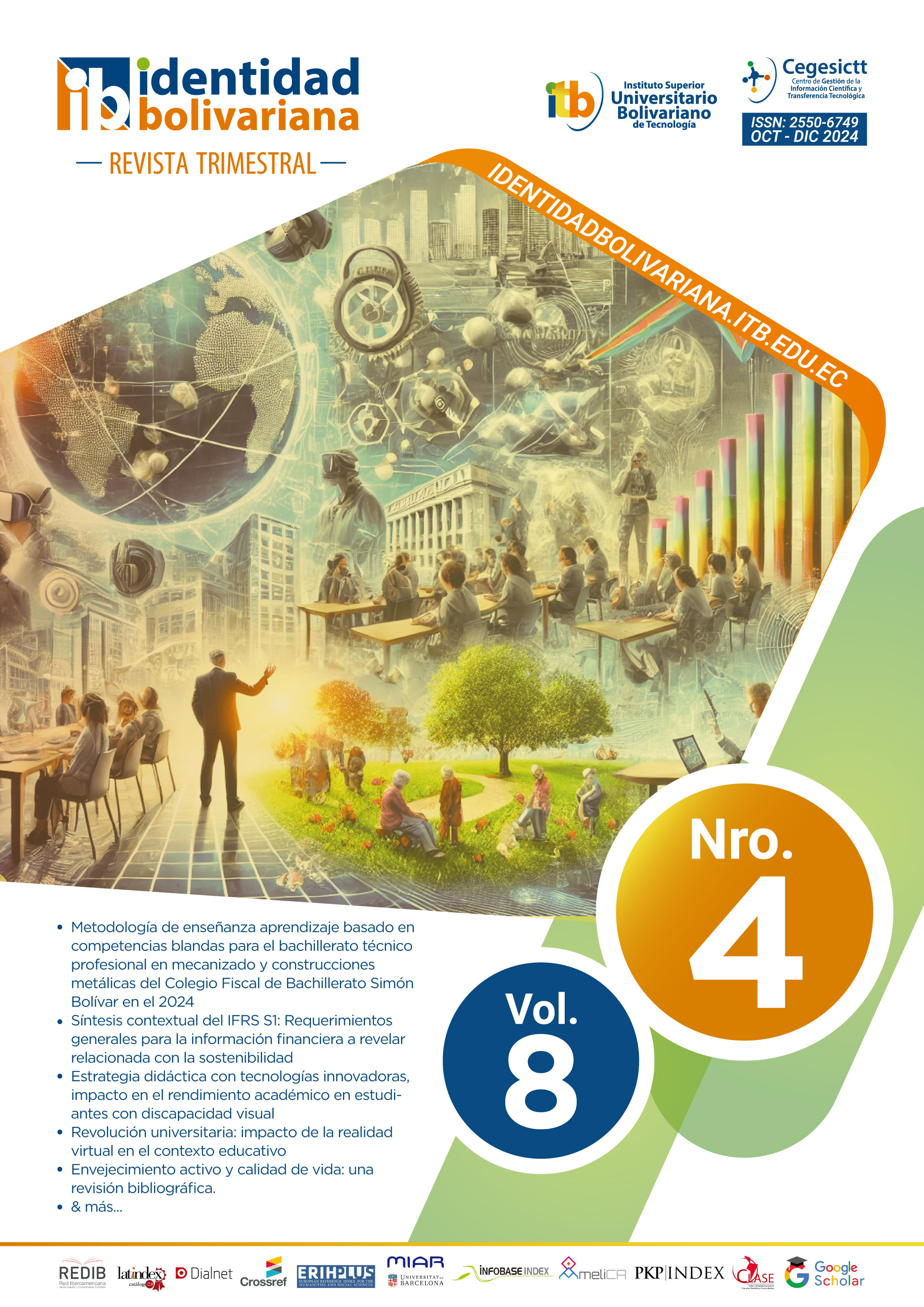Universitary revolution: impact of virtual reality in the educational contextual
Main Article Content
Abstract
The main purpose of this research was to prioritize the use of virtual reality technology as a teaching resource for students with special needs, being essential to enhance the acquisition of knowledge. This enables the effective use of immersive environments in order to obtain effective results. Education takes advantage of technological advances to offer new teaching modalities that contribute to the learning progress of students at the State University of the South of Manabí. The analysis and importance of technologies focused on virtual environments are considered fundamental and essential technological tools for the immersive interaction of students. This technology, as an educational complement, is responsible for improving the traditional teaching-learning approach. The methodology used focused on research with a qualitative approach, the level of depth of the study was presented as exploratory of an experimental type, using methods such as historical-logical, hypothetical-deductive, documentary analysis, bibliographic, observation, interview and mathematical statistics. This study integrated virtual reality technologies as a necessary tool and supplement for educational training achieving quality, promoting the use of technologies through virtual environments as an applicable educational method. It is concluded that education with the use of technology achieves new pedagogical paradigms that facilitate the development of learning in university students.
Article Details
Section
How to Cite
References
Carlos Samaniego Villarroel, J. (2016). Realidad Virtual en la Educación; el Próximo Desafío Virtual Reality in Education; The next challenge (Vol. 1). https://core.ac.uk/download/pdf/235501238.pdf
Cevallos, M. A. S., Laz, E. M. S. A., & Campuzano, M. F. P. (2019). Esfero rojo, esfero azul: Un enfoque tradicional de la educación actual en el Ecuador. Revista Arbitrada Interdisciplinaria Koinonía, 4(8), 803–827. https://dialnet.unirioja.es/servlet/articulo?codigo=7440789
Crespo, R., Riestra, E., Gánem, R., & Cárdenas, D. (2013). Realidad Virtual como herramienta para aprendizaje inmersivo en ingeniería. https://doi.org/10.16/CSS/JQUERY.DATATABLES.MIN.CSS
Díaz-López, L., Tarango, J., & Refugio Romo-González, J. (2020). Realidad Virtual en procesos de aprendizaje en estudiantes universitarios: motivación e interés para despertar vocaciones científicas. Cuadernos de Documentación Multimedia, 31. https://doi.org/10.5209/cdmu.68958
Escartín, E. R., & Echeverría, J. A. (2000). La realidad virtual, una tecnología educativa a nuestro alcance. https://idus.us.es/handle/11441/45510
Hernandez, R. M. (2017). Impacto de las TIC en la educación: Retos y Perspectivas. Propósitos y Representaciones, 5(Impacto de las TIC en la educación), 325–347. https://dialnet.unirioja.es/servlet/articulo?codigo=5904762
Maldonado Zuñiga, K., Caicedo Plúa, C. R., Yanina Holanda, C. P., & Leonardo Raul, M. Q. (2023). Las tecnologías y su aplicación en el proceso educativo en la Universidad Estatal del Sur de Manabí. Serie Científica de la Universidad de las Ciencias Informáticas, 16(3), 22-35. Recuperado a partir de https://publicaciones.uci.cu/index.php/serie/article/view/1314
Maldonado Zuñiga, K., Vera Velázquez, R., Ponce Delgado, L. M., & Tóala Arias, F. J. (2020). SOFTWARE EDUCATIVO Y SU IMPORTANCIA EN EL PROCESO ENSEÑANZA-APRENDIZAJE: SOFTWARE EDUCATIVO Y SU IMPORTANCIA. UNESUM - Ciencias. Revista Científica Multidisciplinaria, 4(1), 123-130. https://doi.org/10.47230/unesum-ciencias.v4.n1.2020.211
Matsuba, Stephen., & Roehl, Bernie. (1996). Using VRML. 768.
Meza, L. R., & Moya, M. E. (2020). TIC y neuroeducación como recurso de innovación en el proceso de enseñanza y aprendizaje. Revista de Ciencias Humanísticas y Sociales, 5, 85–96.https://repository.unimilitar.edu.co/handle/10654/17077
Romero-Rodríguez Antonio Rodríguez García, J. M. (2018). La tecnología móvil de RealidadVirtual en educación. Edmetic, La tecnología móvil de RealidadVirtual en educación, 259. https://doi.org/10.21071/edmetic.v7i1.10139
UNESCO. (2018). Guía para asegurar la inclusión y la equidad en la educación.
Vera Velázquez, R., & Valdés Tamayo, P. (2022). Uso de recursos tecnológicos en la enseñanza de las matemáticas. Journal TechInnovation, 1(1), 29–45. https://doi.org/10.47230/Journal.TechInnovation.v1.n1.2022.29-45

